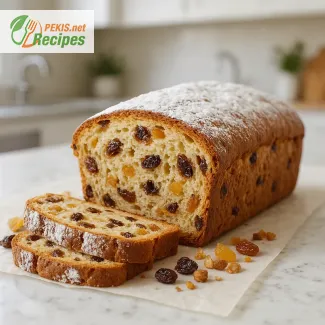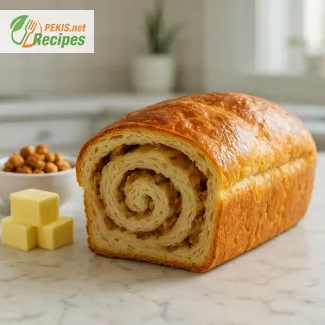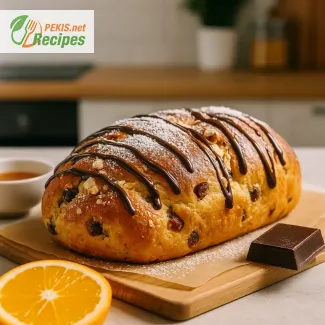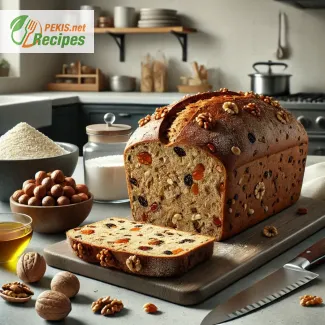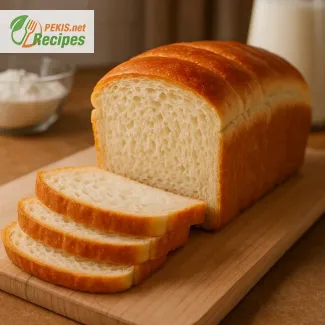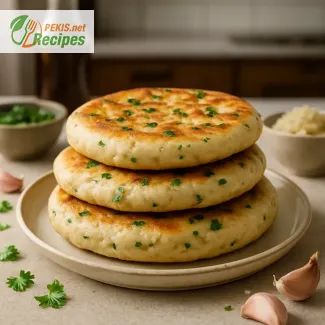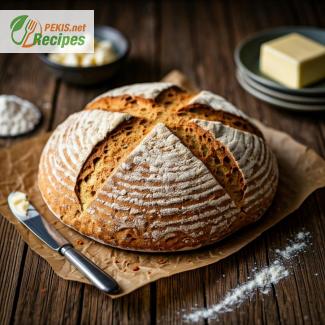
Discover the Timeless Charm of Traditional Irish Soda Bread. Few recipes embody the spirit of Irish heritage like traditional soda bread. This iconic loaf, known for its rustic simplicity and hearty flavor, has been a staple on Irish tables for centuries. With its unmistakable golden crust, tender crumb, and a taste that balances rich tanginess with a hint of nuttiness, soda bread captures the essence of comfort and tradition in every bite.
A Bread Rooted in Simplicity
Traditional soda bread emerged from humble beginnings during the 19th century when Irish families needed an affordable and reliable way to bake bread without yeast. Baking soda, combined with buttermilk, became the star ingredient, transforming pantry staples into a quick and satisfying loaf. The absence of yeast not only made it easy to prepare but also ideal for the unpredictable Irish climate, where natural leavening methods could be challenging.
What sets this bread apart is its no-fuss preparation. With just a handful of ingredients—flour, baking soda, buttermilk, and a pinch of salt—home cooks can create a loaf that is both wholesome and delicious. The result is a bread that pairs effortlessly with a variety of dishes, from hearty stews to creamy butter and sweet jam.
A Texture and Flavor Like No Other
The beauty of soda bread lies in its unique texture and flavor. Its crust is crisp and golden, offering a delightful contrast to the soft, dense interior. The buttermilk adds a subtle tanginess that elevates the overall taste, while the baking soda ensures a light rise, giving the loaf its characteristic shape and rustic charm. When sliced, each piece reveals a tender crumb that holds up beautifully to both savory and sweet toppings.
For many, soda bread evokes a sense of nostalgia, transporting them to cozy family kitchens where the aroma of fresh bread wafted through the air. Whether served warm from the oven or toasted the next day, it never fails to deliver a comforting culinary experience.
Versatility in Every Slice
Soda bread’s adaptability makes it a standout among traditional breads. While the classic recipe remains beloved, variations abound to suit modern tastes and dietary preferences. Additions like raisins, seeds, or herbs can transform the loaf into something uniquely personal, while substitutions such as gluten-free flour or plant-based buttermilk ensure everyone can enjoy its timeless appeal.
Pair your soda bread with traditional Irish butter for an authentic experience, or experiment with global flavors by serving it alongside rich curries or hearty soups. Its versatility makes it a true kitchen staple that complements nearly any meal.
A Celebration of Culture and Community
Beyond its practical appeal, soda bread holds a special place in Irish culture. Historically, a cross was etched into the top of the dough before baking—a symbolic gesture believed to bless the bread and ward off evil spirits. This tradition adds a layer of meaning to the baking process, connecting each loaf to generations of shared history and hospitality.
For those who love to entertain, soda bread is the perfect addition to any table. Its inviting aroma and homey aesthetic immediately make guests feel welcome, and its approachable preparation means even novice bakers can create something extraordinary.
Tips for Perfecting Your Soda Bread
Creating the perfect soda bread is as much about technique as it is about ingredients. To achieve the ideal texture and rise, avoid overmixing the dough; a light hand is key to maintaining its tender crumb. Similarly, bake the bread in a preheated oven to ensure a crisp crust while preserving the soft interior. For a traditional touch, bake it in a cast-iron skillet, which helps achieve an even bake and enhances the bread’s rustic presentation.
A Bread That Stands the Test of Time
Traditional Irish soda bread is more than just a recipe—it’s a celebration of simplicity, resourcefulness, and the enduring power of home-cooked meals. Its iconic status as a symbol of Irish heritage continues to resonate across the globe, making it a beloved treat for anyone who values authentic, heartfelt cuisine.
Whether you’re savoring it for breakfast, lunch, or dinner, soda bread invites you to slow down, connect with tradition, and enjoy the simple pleasure of freshly baked bread.
- Preheat the oven. Set your oven to 200°C (392°F). If you have a cast-iron skillet, place it in the oven to heat.
- Prepare the dry ingredients. In a large mixing bowl, combine the flour, baking soda, and salt. Use a whisk or sift to ensure the dry ingredients are evenly mixed.
- Add the buttermilk. Make a well in the center of the dry ingredients and gradually pour in the buttermilk. Use a wooden spoon or your hands to mix the dough until it just comes together. Do not overmix; the dough should be soft but not sticky.
- Shape the dough. Transfer the dough to a lightly floured surface and shape it into a round loaf. Place the loaf on a baking tray lined with parchment paper or into the heated skillet.
- Score the loaf. Using a sharp knife, cut a deep cross into the top of the loaf. This allows the bread to cook evenly and has a traditional significance in Irish culture.
- Bake. Place the bread in the preheated oven and bake for 35 minutes, or until the loaf is golden brown and sounds hollow when tapped on the bottom.
- Cool and serve. Let the bread cool on a wire rack for at least 10 minutes before slicing. Serve warm with butter or alongside your favorite soup or stew.
Enhancing and Modifying Traditional Irish Soda Bread
Traditional Irish soda bread is a recipe steeped in history and simplicity. Its appeal lies in its rustic charm and the ability to create something delicious with only a handful of ingredients. However, this straightforward recipe is also incredibly versatile, offering room for customization to suit different tastes, dietary requirements, and occasions. Below, you’ll find tips and advice for modifying the recipe, highlighting how each change can impact the flavor, texture, and nutritional value of the bread.
Adjusting the Flour for Texture and Flavor
Wholemeal flour: Replacing some or all of the all-purpose flour with wholemeal flour adds a nutty flavor and denser texture to the bread. Wholemeal flour is rich in fiber, which makes the bread more filling and nutritious, but it will also create a heavier loaf. To balance this, you can use a 50/50 mix of wholemeal and all-purpose flour.
Gluten-free flour: For those with gluten intolerance or celiac disease, a gluten-free flour mix can be used. Choose one that includes xanthan gum or similar binders to mimic the elasticity of gluten. This adjustment will result in a slightly crumblier texture, but the bread will still hold its shape and provide a satisfying taste.
Alternative flours: Experimenting with flours such as spelt or rye introduces earthy, rich undertones. Keep in mind that these flours absorb liquids differently, so you may need to adjust the amount of buttermilk slightly.
Modifying Buttermilk for Tanginess and Texture
Plant-based alternatives: If you need a dairy-free version, replace buttermilk with a mixture of plant-based milk (such as almond, soy, or oat milk) and 1 tablespoon of lemon juice or apple cider vinegar. This substitution mimics the acidity of buttermilk, which is essential for activating the baking soda.
Yogurt: Using plain yogurt thinned with water or milk is another excellent alternative. Yogurt enhances the tanginess of the bread and contributes to a creamier texture.
Sour cream: For a richer flavor, substitute a portion of the buttermilk with sour cream. This will make the bread slightly denser and give it a luxurious taste.
Adding Mix-ins for Flavor and Texture
Sweet additions: Incorporating dried fruits such as raisins, currants, or cranberries adds sweetness and chewiness to the bread. These variations pair beautifully with butter or jam.
Savory enhancements: For a more robust loaf, consider adding grated cheese, chopped herbs (such as rosemary, thyme, or parsley), or seeds (like sunflower, chia, or flax). These additions not only enhance the flavor but also provide extra nutrients and texture.
Nuts: Adding chopped nuts like walnuts, pecans, or hazelnuts creates a delightful crunch and earthy flavor.
Influencing the Crust and Shape
Brushing with buttermilk: Before baking, brush the top of the loaf with buttermilk to create a darker, shinier crust.
Dusting with flour: For a more rustic appearance, lightly dust the loaf with flour before scoring it.
Baking vessels: While a baking tray works well, using a cast-iron skillet or Dutch oven will create a thicker, crispier crust. These methods also help the bread maintain its shape during baking.
Controlling Rise and Texture
Kneading lightly: Soda bread requires minimal handling. Over-kneading can lead to a dense loaf, as it inhibits the quick reaction between the baking soda and buttermilk.
Scoring deeper: Cutting a deeper cross into the dough allows for better expansion and ensures even cooking in the center of the loaf.
Adjusting for Healthier Variations
Reducing salt: Lowering the amount of salt slightly won’t compromise the structure of the bread, but it will make it a better option for those monitoring sodium intake.
Adding seeds: Chia seeds, sunflower seeds, or sesame seeds can be mixed into the dough or sprinkled on top for additional fiber and healthy fats.
Boosting fiber: Using wholemeal flour or adding bran to the dough increases the bread’s fiber content, making it more satisfying and beneficial for digestion.
Enhancing for Presentation and Serving
Toppings: Sprinkle the scored loaf with oats, seeds, or coarse sea salt before baking to enhance both the flavor and visual appeal.
Serving warm or toasted: To elevate the flavor and texture, serve the bread warm with high-quality butter, honey, or cheese. Toasting leftovers gives them a delightful crispness.
Experimenting with Sweet and Savory Pairings
Soda bread’s neutral base allows it to complement a wide range of accompaniments:
- Sweet pairings: Honey, fruit preserves, or even chocolate spread enhance the tangy flavor of the bread.
- Savory pairings: Serve it alongside hearty soups, stews, or smoked salmon for a traditional Irish meal.
Practical Tips for Beginners
Practice makes perfect: Soda bread is forgiving, making it a great recipe for novice bakers. Don’t worry if the dough seems rough—it’s meant to be rustic.
Check doneness: Tap the bottom of the loaf after baking; it should sound hollow, indicating that it’s fully cooked.
Storage tips: Wrap the bread in a clean kitchen towel after cooling to keep the crust soft, or store it in an airtight container for a crisper finish.
Customizing the Recipe for Special Occasions
Festive touches: Add dried fruits, spices like cinnamon, or orange zest for a holiday-themed soda bread.
Mini loaves: Divide the dough into smaller portions to make individual servings—perfect for entertaining or gift-giving.
By understanding the versatility of traditional Irish soda bread, you can create a loaf that suits your preferences while honoring its heritage. These simple modifications allow you to explore new flavors, accommodate dietary needs, and make each bake uniquely yours.
This recipe contains gluten and dairy.
Substitution Tips:
- For a gluten-free version, substitute all-purpose flour with a gluten-free baking flour mix.
- Replace buttermilk with plant-based alternatives such as almond milk mixed with 1 tbsp of lemon juice or vinegar.
- Calcium (50 mg): Supports bone health and muscle function.
- Iron (2 mg): Essential for oxygen transport in the blood.
- Vitamin B1 (Thiamine, 0.2 mg): Promotes energy metabolism.
- Vitamin B2 (Riboflavin, 0.3 mg): Supports skin and eye health.
- Selenium (10 mcg): Protects cells from oxidative stress and supports immune function.
- Vitamin E (0.2 mg): Helps maintain healthy skin and protects cells from damage.
Enjoy this wholesome and authentic soda bread, a true celebration of Irish culinary tradition!
